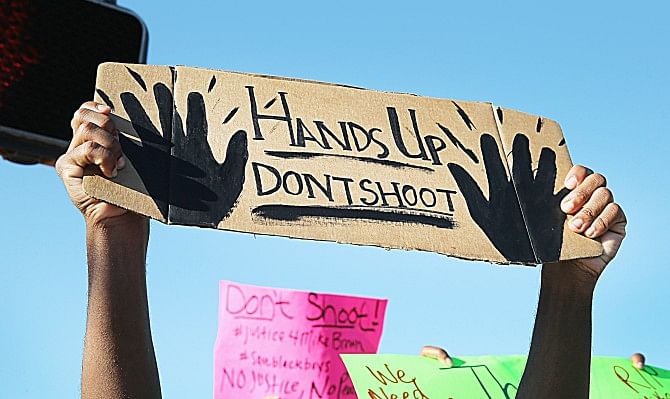The Ferguson Sign

The hands-up -- a sign of surrender and submission black men and boys here say they learn early on when dealing with police -- has been transformed into a different kind of weapon.
"If you're angry, throw your arms up," said the Rev Al Sharpton, who travelled to St Louis in the wake of the death of Michael Brown.
"If you want justice, throw your arms up. Because that's the sign Michael was using. He had a surrender sign. That's the sign you have to deal with. Use the sign he last showed. We want answers why that last sign was not respected."
Brown was shot and killed by an officer on August 9. The 18-year-old, according to witnesses, was running away with his hands up.

Just as "Ferguson" has transformed into instantly recognizable shorthand signifying the latest juncture in an unsettled national conversation over race and policing, the "hands up, don't shoot" chant has joined a long line of activist slogans that crystallize the heart of a community's moral outrage: Hell no, we won't go. No justice, no peace.
Demonstrators had taken up the chant on August 11 when hundreds of demonstrators, many older, marched in the streets in front of the Ferguson Police Department, their arms raised toward the blazing sun. About two-thirds of Ferguson's 21,000 residents are African American, but police and city officials are predominantly white.
The black teens and twentysomethings who took to the streets in Ferguson at night did the same, lifting their hands to the glaring lights of a police chopper and the line of police vehicles -- with officers in front -- trying to keep them at bay.
But they also used the hands-up sign as a tool for provocation, drifting toward the police with their arms up, as if daring for a response. They mixed the hands-up chant with a taunting, obscene anti-police chant. The police eventually drove the group away with tear gas.
Mark Sutton, 24, of St Louis recalled an incident when he was 18. He had gone to the Saint Louis Galleria Mall with his little brother to pick out a prom suit, but ID checkers at the entrance wouldn't let him in.
Sutton said that as he walked away with a cellphone to his ear, a police officer grabbed his hand; surprised, he yanked his arm away and then was thrown to the ground, handcuffed.
"That could have been me in '08," Sutton said of Brown's fate. "I wouldn't be here to tell this story. I wouldn't be here to protest."
Other men at the Clayton rally, young and old, shared similar stories.
"See this dent?" said Aha Sen Piankhy, 38, tapping a finger to a scar on his face. "I got smacked in the head with a flashlight because I didn't say, 'Yes, sir.'"
He added, "I was 14 years old."
Aha Sen said the hands-up chant was "a good tool" because it showed that police apparently violated the covenant not to shoot when hands are up -- a gesture resented among black boys and men in the first place.
Brown, he said, "knew to put his hands in the air, and they still killed him."
But Strong said he detests the new symbol.
"You're showing yourself as weak. It says, 'I give up, I surrender to your authority,'" he said. "Whether his hands were up, if they were down, it doesn't matter."
But when a police officer smirked at protesters on the morning of August 12, Strong decided, the gesture seemed the best way to express displeasure.
Colbi Drake, 22, a student at the University of Missouri, had a different outlook on holding her hands up, citing other cases of young unarmed black men around the country who were killed.
"This is a very peaceful way of representing the people who aren't able to do this themselves," she said. "That was always the symbol of surrendering. 'I have nothing! My hands are up!' Why would you still shoot? It makes no sense."
And then Drake went back to watching the demonstrators facing police, with their arms raised to the sky.
Protesters have also taken their cause to social media, tweeting with the hashtags #handsupdontshoot, #handsup and #JusticeForMikeBrown.
Source: LA Times, Aug 12

 For all latest news, follow The Daily Star's Google News channel.
For all latest news, follow The Daily Star's Google News channel. 



Comments